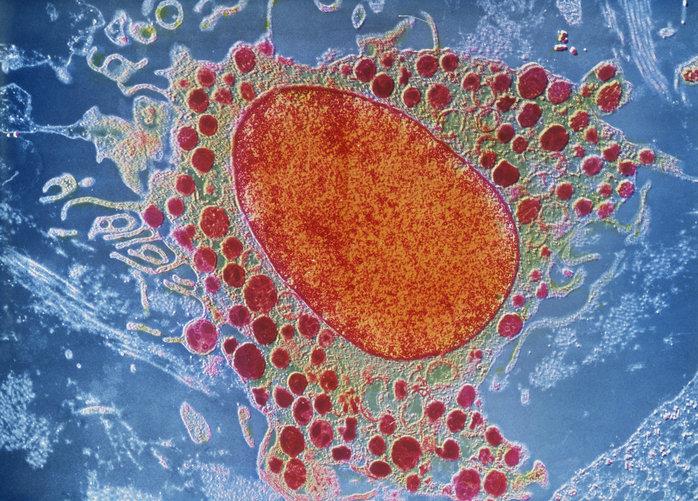

Histamine-releasing factor amplifies food allergies by working in concert with IgE to stimulate the release of histamine from mast cells.
Credit: Sciencephoto Library
Almost eight percent of children under three years old and four percent of adults suffer food allergies, which trigger not only discomfiting symptoms like dermatitis and diarrhea but can cause deadly anaphylactic shock. Allergic responses emerge when food components, like egg, shellfish, or peanut proteins, stimulate white blood cells called mast cells to dump excessive quantities of histamine or cytokines into the blood, fomenting inflammation in skin, eyes, or gastrointestinal tract, among other tissues.
In 2012, LJI researcher Toshiaki Kawakami, M.D., Ph.D., reported that a small protein aptly named histamine-releasing factor (HRF) played a pro-inflammatory role in asthma. His group now extends that work in the November 13, 2017, online issue of The Journal of Clinical Investigation by showing that HRF also serves as a “food allergy amplifier.” The paper reports a novel biochemical mechanism governing HRF activity, paves the way for blood tests to predict which patients will respond to allergy therapy, and strongly supports the idea that drugs designed to block HRF could prevent food allergy attacks.
Kawakami says that the “prevailing view” of the allergy cascade is: 1) allergens ramp up levels of antibodies called immunoglobulin E (or IgE), which then 2) bind to mast cells, and 3) when allergen touches IgE, mast cells release histamine. “But when we began these studies, we suspected that allergens are often present at very low levels, possibly too low to activate mast cells by this pathway,” he says. “Our new paper confirms that once triggered by allergens, HRF proteins bind to IgE and then both synergistically activate mast cells and enhance inflammation.”
To show this, Kawakami's group engineered mice to become allergic (“sensitized”) to egg protein and treated them with an oral HRF inhibitor the lab had developed for use in asthma-related experiments. To test inhibitor efficacy, they then re-exposed treated and untreated mice to egg allergens.
As expected, untreated mice developed diarrhea and signs of gut inflammation. However, these symptoms were delayed or much less severe in inhibitor-treated mice, and the inhibitor reduced the allergen reactivity of mast cells isolated from the gut of allergic mice.
“The fact that orally-administered HRF inhibitors can prevent development of food allergy in a mouse strongly hints that we could create similar medicine to treat humans with food allergy,” says Tomoaki Ando, PhD., the study's first author and now an assistant professor at Juntendo University in Tokyo.
Accordingly, the team observed higher than normal levels of IgE antibodies highly responsive to HRF (what immunologists call “HRF-reactive IgE”) in the blood of children with egg allergies, a strong hint that HRF contributes to food allergy in humans like it does in mice.
The team then monitored those same children as they embarked on a clinical trial of an anti-allergy procedure called rush oral immunotherapy (OIT), in which patients consume increasing amounts of egg several times daily over a few weeks. Once patients achieve desensitization, they keep consuming eggs for 12 months of maintenance period. And then, egg products are withdrawn for two weeks before re-exposure to egg protein, as a test of the therapy's durability.
A key finding in the paper is that children who successfully met this last “challenge”–that is, remained unfazed by egg consumption two weeks after cessation of therapy–maintained low blood levels of HRF-reactive IgE after OIT. In contrast, children who became re-sensitized to egg proteins immediately after OIT interruption observed an increase of HRF-reactive IgE during maintenance period.
Ando sees the association of HRF-reactive IgE increase with OIT failure as a positive outcome in terms of drug discovery, as it reveals HRF to be a target potentially druggable by inhibitors effective in animal models. “In fact, if a patient's allergy remained unchecked independent of HRF levels, that might mean that their condition is going to be more difficult to treat,” he says. “These tests also warrant future clinical monitoring of HRF-reactive IgE levels as a predictor of OIT results.”
Kawakami's lab remains focused on developing potent HRF inhibitors and is currently testing them using mouse models described in this study. His goal is to decrease patients' risk of allergic shock, so they can enjoy the simple pleasures of a normal life, like going out to eat.
“I hope to see protection for patients who go to a restaurant and don't know what ingredients are in the food,” says Kawakami, a professor in LJI's Division of Cellular Biology. “In the future, they might take an oral inhibitor as a preventive measure. Our biggest concern for these individuals remains anaphylaxis–it's potentially lethal.”
###
The study was funded by grants from the National Institutes of Health (HL124283, AR064418, AI115534 and AI124734), the Ministry of Education, Culture, Sports, Science and Technology, Japan (25670483, 26860765, 15K10794), the Japan Research Foundation for Clinical Pharmacology, and the Nipponham Foundation for the Future of Food.
Full citation: “Histamine-releasing factor as a food allergy amplifier”, Tomoaki Ando, Jun-ichi Kashiwakura, Naoka Itoh-Nagato, Hirotaka Yamashita, Minato Baba, Yu Kawakami, Shih Han Tsai, Naoki Inagaki, Kiyoshi Takeda, Tsutomu Iwata, Naoki Shimojo, Takao Fujisawa, Mizuho Nagao, Kenji Matsumoto, Yuko Kawakami, and Toshiaki Kawakami, Journal of Clinical Investigation (2017).
About the La Jolla Institute for Allergy and Immunology
The La Jolla Institute for Allergy and Immunology is dedicated to understanding the intricacies and power of the immune system to that we may apply that knowledge to promote human health and prevent a wide range of human diseases. Since its founding in 1988 as an independent, nonprofit research organization, the Institute has made numerous advanced leading toward its goal: life without disease.
Media Contact:
Gina Kirchweger
gina@lji.org
858.357.7481















